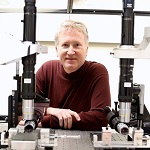A Revolution in High-Q Integrated Photonics
Hosted By: Optical Fabrication and Testing Technical Group
25 April 2022 14:00 - 15:00
Eastern Time (US & Canada) (UTC -05:00)High-Q microresonators in the form of rings or disks provide access to nonlinear optical phenomena at milli-Watt power levels. And the resulting device functions, now in miniature form, are paving the way to compact (and even fully integrated) optical systems for sensing, metrology, spectroscopy, microwave generation, time keeping, and data transmission. Once discrete and reliant upon specialized processing techniques for optical loss reduction, high-Q microresonators are today planar, capable of integration, and in some cases fabricated on CMOS foundry lines.
After a brief overview of their history and early nonlinear optical demonstrations, Kerry Vahala will focus on three areas that illustrate the broad impact of high-Q microresonators. First is their application to Sagnac gyroscopes where recent demonstration of Earth rotation measurement using a Brillouin ring laser gyroscope will be presented. Second is the subject of frequency microcombs with an overview of system demonstrations as well as the recent integration of microcombs with pump laser diodes. Third is a hybrid integrated semiconductor laser with short and long term coherence surpassing high-performance fiber lasers. In each subject area, the fundamental device operating principles will also be presented. Finally, the current and possible future limits of microresonator performance, and untapped application areas, will be discussed during the webinar.
What You Will Learn:
- How microresonators have evolved to become critical elements in new photonic integrated systems
- An overview of recent progress in compact, chip-based gyroscopes, microcomb systems and high-coherence semiconcuctor lasers.
- The current and possible future limits of microresonator performance
Who Should Attend:
- Researchers interested in sensing, frequency metrology, gyroscopes, compact sources of high coherence, and optical communications
- Anyone interested in new directions for integrated photonics
About the Presenter: Kerry Vahala, Caltech
 Kerry Vahala is Jenkins Professor and Professor of Applied Physics at Caltech. He studies devices called optical microcavities and their application to miniature frequency and time systems, microwave sources, parametric oscillators, astrocombs and gyroscopes. Vahala also made early contributions to the subject of cavity optomechanics and demonstrations of chip-based devices to cavity QED phenomena. A member of the National Academy of Engineering and Fellow of the IEEE and Optica, he received the IEEE Sarnoff Medal for research on quantum-well laser dynamics, the Alexander von Humboldt Award for work on ultra-high-Q optical microcavities, a NASA achievement award for application of microcombs to exoplanet detection, and the Optica Forman Team Engineering Excellence Award for a 2-photon optical clock.
Kerry Vahala is Jenkins Professor and Professor of Applied Physics at Caltech. He studies devices called optical microcavities and their application to miniature frequency and time systems, microwave sources, parametric oscillators, astrocombs and gyroscopes. Vahala also made early contributions to the subject of cavity optomechanics and demonstrations of chip-based devices to cavity QED phenomena. A member of the National Academy of Engineering and Fellow of the IEEE and Optica, he received the IEEE Sarnoff Medal for research on quantum-well laser dynamics, the Alexander von Humboldt Award for work on ultra-high-Q optical microcavities, a NASA achievement award for application of microcombs to exoplanet detection, and the Optica Forman Team Engineering Excellence Award for a 2-photon optical clock.
